Black hole journey
Research on weird, invisible objects called black holes might help explain how the universe began.
By Emily Sohn
There are all sorts of holes: big ones and little ones, deep ones and shallow ones. There are swimming holes and buttonholes, cheese holes and bullet holes. Then, there are black holes.
These mysterious, bizarre objects pack a huge mass into a tiny volume. Their gravity is so strong that they gobble up anything that comes near them, even stars, gas, and light. They’re invisible. They’re like cracks in space, and they lurk all over the universe.
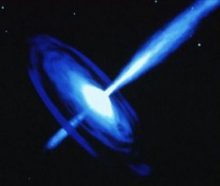 |
|
An invisible, massive, spinning black hole may lie at the center of this galaxy, as shown in an artist’s illustration. The black hole would pull in material from a swirling disk of nearby gas and stars. The extremely high temperatures and pressures produced near the black hole would also cause some of the gas to be ejected, creating a huge galactic jet (from center to top right). |
| Dana Berry, Space Telescope Science Institute |
If you were to jump into a black hole (something that no one has yet figured out how to do), you’d be stretched from head to toe and squeezed from side to side into a long string of human spaghetti. Finally, you’d get pulverized into the tiniest bits imaginable.
“If you were to fall in, what remains of you would eventually come out as light and other particles,” says Tom Banks. He’s a physicist who spends a lot of his time thinking about black holes and trying to understand them.
“There wouldn’t be much of you that we could recognize,” Banks says. “It would be as if we had burned you up in a fire. Everything in the body would come out as nothing more than radiation and ashes.”
Both scientists and nonscientists find black holes fascinating. The whole idea sounds crazy, and it can be hard to wrap your head around something that seems like it should be impossible. Nevertheless, new observations and thought experiments are shining light into the darkness.
Astronomers now suspect that there’s a black hole at the center of just about every galaxy in the universe. Some researchers even suggest that the universe was once a big ball of black holes, before there were any stars or planets.
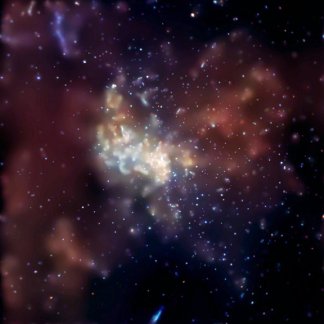 |
|
This image taken by the Chandra X-ray Observatory, shows a region at the center of our own Milky Way galaxy that appears to host a supermassive black hole.
|
| NASA/CXC/MIT/F.K.Baganoff et al. |
Further research on black holes might eventually help explain how the universe began, Banks says. He works at Rutgers University in New Brunswick, N.J., and at the University of California, Santa Cruz.
“One of the questions we ask ourselves is, ‘What happened in the very, very earliest moments of the universe?'” he says.
Supernovas and gravity
A century ago, Albert Einstein’s theory of gravitation predicted that black holes might exist. But no one wanted to believe it, including Einstein himself. Astronomers finally began to detect signs of black holes in the 1980s.
Scientists now are pretty sure that a black hole can form when a huge star reaches the end of its life and runs out of fuel. First, the inner part of the star collapses. Then there’s an enormous explosion called a supernova, sending light and matter into space. Eventually, the entire mass of what’s left of the star gets squeezed into the tiniest space imaginable—forming a black hole.
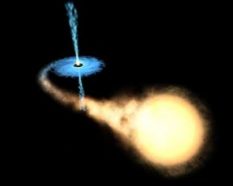 |
|
This artist’s illustration shows a black hole, together with its whirling disk of matter, hurtling like a cannonball through the disk of our own galaxy. Astronomers say that such a black hole, only several times more massive than the sun, is created when a dying, massive star explodes in a violent supernova. |
| ESA, NASA, and Felix Mirabel |
The more mass an object has, the more gravity it has. So, black holes have a lot of gravity. Black holes formed in a supernova may be only a few times the mass of our sun. On the other hand, black holes at the centers of galaxies may have a billion times as much mass as the sun, all crammed into a very small space.
Earth’s gravity keeps us on the ground; a black hole’s gravity sucks things in. Its pull is so strong that not even light can escape. That’s why it looks black—as if there’s nothing there.
A black hole’s size is defined by an invisible boundary called an event horizon. Anything—you, atoms, or light—that gets sucked in and crosses the boundary can never get back out again.
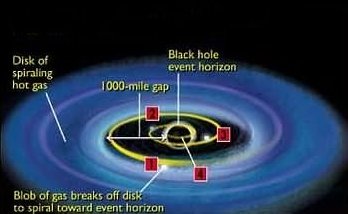 |
|
The event horizon is the boundary between a black hole and the rest of the universe. Any matter that spirals in toward the black hole and crosses the event horizon disappears.
|
| Ann Feild, Space Telescope Science Institute |
The more you think about black holes, the harder it is to imagine how they could possibly exist. That’s what most interests many people, Banks says.
When he was a kid, Banks always wanted to know about extremes—the tallest building in the world, the deepest part of the ocean, the most of anything. “In that sense, black holes are the ultimate extreme,” he says.
That’s also what intrigues many scientists about black holes. “It’s the ultimate limit on how much you can squeeze stuff together,” Banks says. “This suggests that black holes tell us something about the fundamental theory of what matter or the universe looks like in its most extreme condition.”
Data and theory
Because black holes are so weird (not to mention invisible), they can be difficult to study.
Scientists tackle this problem in two ways. Some use telescopes to make observations, staring into the sky and looking for signs of radiation that signal the presence of a black hole. Others use mathematics and computers to develop theories about black holes and explore the behavior of equations that describe such objects. They do thought experiments.
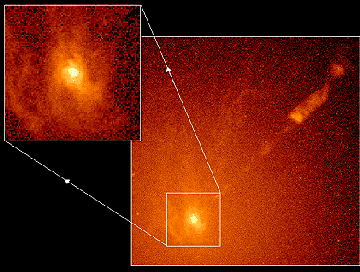 |
|
Black holes can be detected only by their effects on matter surrounding them. This Hubble Space Telescope image shows a rapidly rotating disk of material at the core of a galaxy known as M87. The existence of such a disk of hot, spinning material suggests that there’s a black hole at its center. This particular black hole would weigh as much as 3 billion suns, yet would be no larger than our solar system. |
| Holland Ford, Space Telescope Science Institute/Johns Hopkins University, et al., NASA |
Theorists, such as Banks, look at data and try to understand observations made by astronomers. They attempt to put it all together to explain how the universe came to look the way it does now.
For example, astronomers observe many different kinds of galaxies. At the same time, theorists develop equations that link the shapes of galaxies to how they formed and evolved. Researchers can then compare what the formulas predict to what’s actually seen in the sky.
“You continually go back and forth between observations and theory,” Banks says. “If the theory doesn’t work, you change it a little bit until you get something that works better.”
This type of thinking has led some theorists to propose that entire galaxies can actually collapse into black holes.
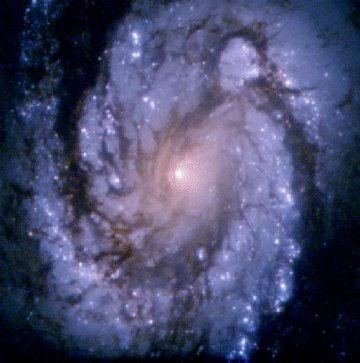 |
|
Our own Milky Way galaxy may look like this spiral galaxy known as M100.
|
| NASA, Space Telescope Science Institute |
A complicated set of ideas called “string theory” has also led some physicists to suggest that the universe once held a whole bunch of black holes, all scrunched together. Eventually, these black holes grew and separated, and each one formed a galaxy around itself. It’s possible that every galaxy visible today has a massive black hole at its center.
But the equations developed so far by theorists provide only part of the picture. The rest is still a work in progress. With string theory and other ideas, scientists hope eventually to come up with a grand explanation for how everything came to be.
But, even if researchers do get all the numbers to work, black holes and the history of the universe might always remain something of a mystery.
“We weren’t there at the beginning of the universe,” Banks says. “We can’t go look. We make theories to predict what we see today. We don’t yet have a good enough theory to pin it all down.”
Ready to jump in?
Going Deeper:







